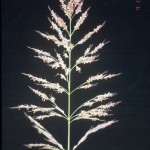Johnsongrass
Sorghum halepense
Poaceae
Description
Johnsongrass is a vigorous, coarse, perennial grass with scaly root stalks. It reproduces by underground rhizomes and seeds. This grass has broad leaves and grows 3 to 6 feet tall. The numerous seeds that develop in the fall are yellow to purplish, occurring in a large, spreading, open seed head. Johnsongrass is a perennial, warm-season, introduced - 36 to 72 inches tall. Good grazing for livestock, but under certain conditions it produces prussic acid, which is poisonous to livestock. Fair grazing for wildlife.Habitat
Johnsongrass was introduced into South Carolina from Turkey in the early 1800s. Since then, it has spread across most of the southern United States. Johnsongrass is considered a weed in cultivated fields. It grows well in disturbed soils, along irrigation ditches and stream bottoms. In some situatons, it is valued as a forage and erosion control plant.Toxic Agent
Sorghum forages under the stress of rapid growth or drought generate cyanogenic glycosides, which are converted to free cynanide in the rumen. Free cyanide may be present in freshly frosted plants. Most losses from johnsongrass are caused by cyanide poisoning. All domestic animals are susceptible to cyanide; ruminants are the most susceptible. The plant can also accumulate dangerous levels of nitrates after fertilization and during drought. In most instances, the plant is fair forage, but it becomes toxic under conditions favoring cyanide or nitrate accumulation.Signs of Livestock Ingestion
Cyanide is one of the most rapidly acting poisons. Signs of illness may begin within 5 minutes after consumption. Death may occur within 15 minutes or several hours. Clincal signs generally occur in this order: Salivation and labored breathing; Muscle tremors; Incoordination; Bright red venous blood; Convulsions; Death. High nitrate levels in the plant can complicate the problem and produce nitrate poisoning in sheep and cattle (see Descriptions of Animal Conditions). Sorghum cystitis may be produced in horses. This disease is characterized by loss of control of the rear legs and bladder, resulting from permanent damage to the spinal cord. The agent that causes this condition is unknown.Management Strategies
Even plants containing high levels of cyanogenic glycosides might not poison livestock. Because poisoning depends on the presence of free cyanide, anything preventing its development in the digestive system can lessen or eliminate the danger of poisoning. Certain feeds, such as alfalfa hay and linseed cake, retard cyanide release. Treat livestock showing signs typical of cyanide poisoning with sodium nitrite and sodium thiosulfate. If nitrate poisoning is the problem, treat with methylene blue. The best preventive measure is to defer infested pastures during danger periods. Only a small percentage of horses consuming sorghum develop cystitis. However, there is no treatment and the animals must be destroyed. Therefore, never feed sorghum forage or hay as a staple diet to horses.Images
Plant Characteristics
Seed Type: Non-Encapsulated
Duration: Perennial
Stem Texture: Hairless/Smooth
Growth Habit: Grasses, Sod grass
Leaf Shape
 : Simple with Pinnate or Parallel Venation
: Simple with Pinnate or Parallel Venation
Season: Warm
Distribution
 : 01 - Pineywoods, 02 - Gulf Prairies and Marshes, 03 - Post Oak Savannah, 04 - Blackland Prairies, 05 - Cross Timbers and Prairies, 06 - South Texas Plains, 07 - Edwards Plateau, 08 - Rolling Plains, 09 - High Plains, 10 - Trans-Pecos
: 01 - Pineywoods, 02 - Gulf Prairies and Marshes, 03 - Post Oak Savannah, 04 - Blackland Prairies, 05 - Cross Timbers and Prairies, 06 - South Texas Plains, 07 - Edwards Plateau, 08 - Rolling Plains, 09 - High Plains, 10 - Trans-Pecos
Distributions
Distribution refers to the ecological region in Texas that a plant has been found. You can also view a clickable map.
Book: Know Your Grasses (B-182), Toxic Plants of Texas (B-6105)
Collection: Grasses, Toxics
Livestock Affected: Cattle, Goats, Horses, Sheep
Livestock Signs: Bright Red Blood, Convulsions, Excess Salivation, Incoordination, Irregular Breathing, Nitrate Poisoning, Trembling





